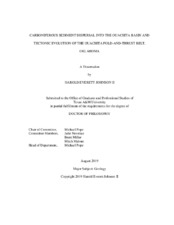| dc.description.abstract | The highly-deformed rocks of western Arkansas to eastern Oklahoma, record the Late Paleozoic tectonic history of the southern boundary of the North American Craton. The Mississippian rocks (i.e., Stanley Group) were deposited in the Ouachita Basin, a basin located adjacent to the North American Craton. Detrital zircon and muscovite spectra indicate a shift in sediment sourcing from Gondwanan crust in Mississippian to Laurentian crust during deposition of the Pennsylvanian Jackfork Group. This provenance shift suggests the craton was exposed and distal sediments were carried 100s of kilometers by large rivers to the Ouachita Basin. A lack of Alleghanian-aged sediment precludes a paleo-drainage linking the Ouachita Basins to any eastward basins indicating that the Cincinnati Arch served as the drainage divide. Thermal maturation, illite and chlorite ‘crystallinity’, indicate sufficient burial to reach temperatures ~ 300°C. Using a reasonable range for the geothermal gradient of 15 to 40°C, an estimated 8-14km of overburden were removed from above the present-day Benton Uplift, western Arkansas. Folding and thrust faulting of the Stanley and Jackfork groups occurred during the final stages of the Ouachita orogenesis. As the Ouachita Orogen evolved, wedge models predict the shape and sequence of internal structure development. Thermochronology was used to date the cooling of the rocks through temperatures of approximately 205°C, 180°C, and 110°C using techniques of zircon fission track, (U-Th)/He zircon, and apatite fission track, respectively. Zircon fission track minimum ages (259 ± 34 Ma to 365± 66 Ma) were determined from 643 grain analyses. (U-Th)/He zircon dates span 181.6 ± 14.53 Ma to 1964.2 ± 157.13 Ma, with the youngest date for each sample providing a range from 181.6 ± 14.53 Ma to 347.6 Ma.
Zircon fission track minimum ages record development of the fold and thrust belt (FTB) wedge, whereas the (U-Th)/He dates give paleotopography of the critical wedge. Thus, the internal motion of thrusts and folding of the FTB occurred Pennsylvanian to Early Permian. Paleotopography slope was foreland-directed with the present-day surface of the Broken Bow Uplift buried at ~9 km during Late Triassic-Middle Jurassic, assuming geothermal gradient of 20°C/km and zircon (U-Th)/He closure of ~180°C. | en |


